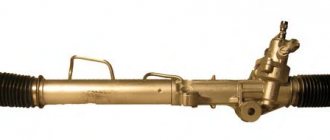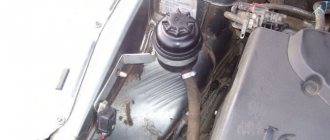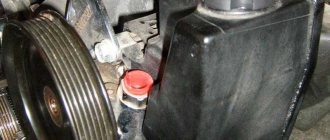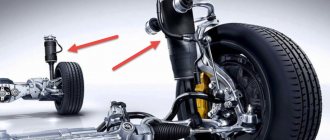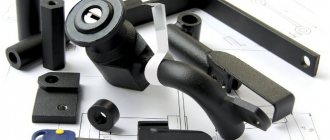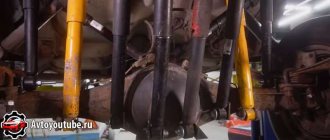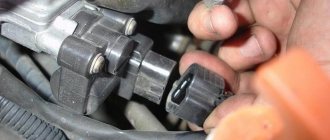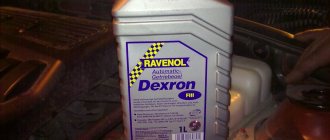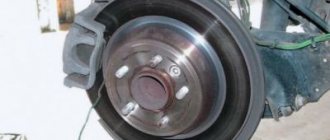To reduce the force applied by the driver to the steering wheel when turning the car, amplifiers are used. They perform the following functions: provide kinematic tracking action, i.e. proportionality between the angles of rotation of the steered wheels of the vehicle and the steering wheel; create a forceful tracking action - “road feeling”, i.e. they ensure proportionality between the force applied by the driver to the steering wheel and the resistance to turning the car’s steered wheels (the smaller the car’s turning radius and, therefore, the larger the steering angles, the greater the torque resistance to their rotation); allow you to drive the car when the amplifier fails; increase traffic safety, as they provide the ability to control the car if a tire breaks on the steered wheel, which is especially...
Power steering: from trucks to cars
Hydraulic power steering (Power Steering) is a unit hidden in the bowels of our cars that creates additional effort to turn the wheels, thereby helping us steer without straining our muscles.
Despite the fact that the use of these devices on passenger cars began around the end of the 50s of the last century, they were considered something exotic for many decades.
However, the history of power steering does not even go back to the 50s; it all started much earlier. Thus, the first patent for a device resembling the current power steering was received already in 1902.
The following years, marked by the rapid development of the automotive industry, determined the niche where the hydraulic booster felt best and was considered the most useful - trucks.
History of appearance
The first power steering appeared in 1823. His father is Robert Gurney. In our country they started talking about power steering only in 1950. The first domestic car to be equipped with this element was the premium ZIL-111 at that time. This car was used to transport the country's top officials, so comfort came first here. Currently, power steering is used everywhere. It is difficult to imagine a car without this device (even in its basic version). Some vehicles are equipped with more advanced mechanisms - electric boosters and hydroelectric boosters. However, conventional power steering still remains the most common. Over time, the design of this element was refined and changed. Therefore, it is worth considering in more detail the structure of a modern power steering.
Pros and cons of power steering
By checking in practice how power steering works in a modern car, you can evaluate all the advantages of using this mechanism:
- Reliability. The hydraulic booster system has been tested by many years of practice on various cars, so at the moment it is installed on approximately 60% of cars produced.
- The power steering is capable of developing decent power and overcoming significant resistance from the wheels. This makes it possible to use it on vehicles of any carrying capacity and dimensions.
- Comfort for the driver is the main advantage of power steering. It was created precisely for this purpose - to make it easier for a person to control the machine.
- Improved handling. Since the steering wheel rotates easily, the driver is able to react faster to changing traffic situations.
In addition to power steering, passenger cars are equipped with new generation amplifiers that turn the front wheels using an electric motor (EUR). But such systems cannot yet compare with hydraulics in cost, and therefore fewer new vehicles are equipped with EUR.
The use of hydraulic boosters in steering mechanisms gives another bonus to car manufacturers. Since they do the physical work instead of the driver, the design can use steering mechanisms with a smaller gear ratio. For a car enthusiast, this means that the number of turns of the steering wheel from one extreme position to the other will decrease, which will increase the sharpness of control. True, if the power steering fails or the car is towed, it will be much more difficult for the driver to turn the steering wheel.
Hydraulic amplifiers have the following disadvantages:
- To avoid causing damage, the steering wheel should not be held in any extreme position for a long time, especially at high engine speeds. Due to critical pressure, oil can squeeze out the seals and leak out.
- The pump drive device is designed so that it works non-stop together with the power unit. Because of this, the pump constantly wears out, requires periodic maintenance and takes away part of the engine's energy, increasing fuel consumption.
- Other elements of the system also need to be maintained, and the level of hydraulic fluid in the reservoir must be monitored.
- In cars of the budget price category equipped with power steering, the steering wheel becomes uninformative, especially when driving at high speed.
In more expensive cars, a special device for the power steering pump is implemented, which allows the oil pressure in the system to be reduced as the speed increases . At the same time, the steering wheel “fills” with a pleasant heaviness and there is no feeling of emptiness when steering at speed.
Major breakdowns
Since power steering is a mechanism, sooner or later it may break. Especially considering that he is constantly on the move. The frequency of breakdowns and their severity depends on the intensity of use of the hydraulic booster and its design. In practice, the following faults most often appear:
- the pump is noisy;
- the pump belt becomes loose or worn out;
- the filter element in the tank becomes clogged;
- the pump itself breaks down;
- the pump valve is clogged;
- insufficient viscosity of the filled liquid;
- the hydraulic system becomes clogged;
- depressurization;
- there is not enough liquid in the tank.
If one of the above malfunctions occurs, it becomes difficult to turn the steering wheel to one side, shocks are transmitted more strongly, and noise and vibration also appear.
Power steering device
Power steering is a closed, interconnected hydraulic system of components consisting of:
- Pump.
- Distribution device.
- Hydraulic cylinder.
- Backa.
- High and low pressure hoses.
Pump
The main part of the power steering design is the pump. With its help, pressure is created in the power steering and oil circulates in the system. It is fixed near the engine and driven by the crankshaft using a belt or gear drive (drive). The most common type of pump is a vane pump, usually a vane pump; it provides high wear resistance and high efficiency. However, it has a weak link, namely the bearing, which is why it has to be repaired. The pressure in this type of pump is about 150 bar, which is very high.
We recommend: Electric power steering: device, description, purpose, operating principle, operating mode
Distributor
The distributor in the power steering is a kind of regulator that directs oil from the reservoir to the hydraulic cylinder and back. It can be installed both on the steering gear shaft and on some parts of the steering mechanism. There are two types of distributor:
- axial - if the spool makes translational movements;
- rotary - if it makes rotational movements.
Hydraulic cylinder
Or as the power cylinder is also called, it performs the function of turning the wheels. The fluid in the power steering presses against the piston under pressure and forces the rod to extend, causing the wheels to turn. In order to push the rod back, the fluid from the reverse side presses on the piston and the wheels return to their original position. The hydraulic cylinder can be located both on the steering mechanism and between the steering gear and the vehicle body.
Tank
A reservoir for working fluid, which ensures the operation and lubrication of all connecting parts of the power steering. It contains a special filter to prevent dirt from entering, since the distributor is very sensitive to this. To check the oil level there is a special dipstick and marks on it. The tank is located under the hood, usually in a visible place next to the antifreeze tank and has a cylindrical shape.
High and low pressure hoses
Of course, all fluid circulation through the power steering system is provided by hoses, which are divided into:
- high pressure hose;
- low pressure hose.
High pressure power steering hoses circulate oil between the pump, rotary or axial distributor and hydraulic cylinder. And low pressure returns this oil from the distributor to the tank, as well as from the tank to the pump. It is important to monitor the condition of the hoses to avoid fluid leaks and damage to the entire mechanism.
Which power steering pump to buy
First of all, the similarity of the new mechanism to original spare parts is taken into account. For this, the vehicle's VIN code is used. This will allow you to select an analogue for the faulty pump that will suit all parameters, including overall dimensions. This factor also makes it possible to avoid purchasing a pump that will create pressure lower or higher than required.
Another option is to select a pump based on the code of the old device. Take into account that elements that are not native and suitable for the car brand quickly fail.
Price
Do not purchase cheap or used spare parts, since there is no guarantee that they will work fully for a long time.
Manufacturer
The choice should be made only among trusted brands that have a positive reputation in the market and a minimum number of negative reviews.
Equipment
When purchasing, it is advisable to purchase pumps with a complete set, which allows you to avoid purchasing additional necessary elements. Installation or repair of the device should only be carried out by specialists or persons with the necessary experience. Otherwise, incorrect installation will affect the usefulness of the work and the duration of operation.
Power steering operating principle
If the car is stationary, moving straight, the pump pumps idle hydraulic oil inside the system. When the steering wheel begins to move, the torsion bar begins to twist, and the spool rotates relative to the distribution sleeve. At the same time, connecting hoses open, through which oil from the tank enters a certain chamber in the power cylinder (this depends on which direction the car maneuvers under the influence of turning the steering wheel). And from another chamber, hydraulic oil simultaneously enters the tank through open ducts. The cylinder piston moves the steering rack, while simultaneously transmitting force to the steering rods that turn the wheels.
If the car maneuvers at low speed, then the efficiency of the power steering is maximum. This is achieved by increasing the number of revolutions of the pump motor. An increase in its performance contributes to an intensive flow of hydraulic fluid into the cylinder and the force applied to turning the steering wheel decreases significantly. Increasing the speed of the machine reduces the rotation speed of the electric motor, and the solenoid valve comes into action, which reduces the flow of the hydraulic system channels, and more effort has to be applied to turn the steering wheel.
How does it work
In cars without power steering, the steering wheel is connected through a shaft by a gear to a rack - a simplified diagram. When the steering wheel is turned, the rotation is transmitted through the shaft and gear to the steering rack, which moves in the opposite direction. It is connected to the wheels by rods. Thanks to this design, the wheels turn in the desired direction.
In modern cars, a hydraulic cylinder is built into the steering rack. From the actuator, two tubes are supplied to it, attached to its different sides. When turning to the right, valves (cavities) open in the actuator. Hydraulic fluid from the power steering pump presses on the right side of the hydraulic cylinder. It moves to the left, dragging the steering rack with it. The wheels turn not due to the physical strength of the driver, but due to increased pressure in the cylinder. When turning to the left, other cavities in the distribution mechanism open, the liquid presses on the opposite side of the cylinder, the piston moves to the right along with the rack.
Thus, the hydraulic booster helps the driver to turn the car’s wheels in the desired direction without applying sufficient muscle force.
Diagram of power steering and elements
The hydraulic booster is an important steering component of a car. It consists of a pump, distributor, hydraulic cylinder, connecting hoses, working fluid, and barrel.
Let's look at each of the components in more detail.
- Pump. This device provides the entire system with the required pressure to create oil circulation. Most often, plastic pumps are used for modern cars. This is because they have a high efficiency and at the same time have an increased service life. The pump is usually located on the power unit. The drive operates via a belt drive that interacts with the crankshaft.
- Distributor. This element is designed to direct and distribute the working fluid (oil) into certain cavities of the cylinder, and also supplies it back to the barrel. There are two types of distributors: rotary and axial. It depends on how the spool moves. In the case when it has translational movements, the distributor is called axial. It is called rotary when the spool rotates. The distributor can be located both on the shaft with the steering mechanism and on the steering gear elements. This element is highly sensitive to oil contamination.
- Hydraulic cylinder. This element of the hydraulic booster system drives the pistons and rod under the influence of oil supplied under pressure. The wheels turn using levers. It can be built into the steering mechanism, and can also be seen between the drive and the car body.
- Connecting hoses. Such elements are simply necessary in a power steering system. Their main job is to ensure the smooth flow of working fluid throughout the entire mechanism. All connecting elements can be divided into two types: low and high pressure. Low pressure hoses are designed to return oil from the tank to the pump and, after working out, back to the tank. The second type of hose provides fluid supply between the cylinder, pump and distributor.
- Working fluid. This is a special oil that supplies force to the hydraulic cylinder from the pump. It also ensures lubrication of all system elements.
- Tank. A container for storing and circulating working fluid. The tank has a special filter, which helps clean the liquid supplied to the system. It also has a dipstick with special marks, which is designed to check the oil level.
We recommend: How do valves work in an engine?
Requirements for hydraulic booster
For the power steering to operate effectively, the following requirements are imposed on it:
- system reliability and quiet operation;
- ease of maintenance and minimal device size;
- manufacturability and environmental safety;
- small turning torque on the wheel with automatic return to neutral;
- lightness and smoothness of steering;
- ensuring kinematic tracking action - correspondence between the angles of rotation of the steered wheels and the steering wheel;
- ensuring force tracking action - proportionality between the forces of resistance to turning the steered wheels and the force on the steering wheel;
- the ability to drive a car if the system fails.
Power steering device
Main components of power steering
Power steering is installed on any type of steering mechanism. For passenger cars, the rack and pinion mechanism is most widespread. In this case, the power steering scheme is as follows:
- tank for working fluid;
- oil pump;
- spool valve;
- hydraulic cylinder;
- connecting hoses.
Power steering reservoir
Power steering reservoir
A filter element and a dipstick are installed in the tank or reservoir for the working fluid to monitor the oil level. Oil lubricates the rubbing pairs of mechanisms and transmits force from the pump to the hydraulic cylinder. A mesh in the tank serves as a filter from dirt and metal shavings that arise during operation.
The liquid level inside the tank can be checked visually if the tank is made of translucent plastic. If the plastic is opaque or a metal reservoir is used, the fluid level is checked using a dipstick.
In some cars, the fluid level can only be checked after briefly running the engine or by turning the steering wheel several times in different directions while the car is idling.
Special notches are made on the probes or reservoirs, both for a “cold” engine and for a “hot” one that has already been running for some time. Also, the required liquid level can be determined using o and “Min”.
Frequency of power steering fluid replacement
Theoretically, the working fluid can be used throughout the entire life of the vehicle, but it is recommended to change the oil periodically.
The timing of replacement depends on the intensity of use of the vehicle. With an average annual mileage of 10-20 thousand km, it is enough to change the oil once every two to three years. If the machine is used more often, then the fluid needs to be changed more often.
As a result of the operation of the hydraulic booster, the temperature of its elements increases. Due to this, the oil also heats up, which leads to a deterioration in its physical properties. If, when monitoring the condition of the fluid, foreign particles or the smell of burnt oil are noticed, then it is time for a replacement.
The volume of liquid during a complete replacement will not exceed one and a half liters. For liquid, two levels are measured: cold and hot. The cold level is the point at which the oil temperature is between zero and thirty degrees. The hot level is the point where the temperature of the liquid varies from fifty to eighty degrees.
Pros and cons of power steering
The indisputable advantage of power steering and its main property is to make the work of your hands easier when maneuvering during parking. But the amplifier has another useful property - it softens the force on the steering wheel from impacts on uneven roads.
The disadvantage of power steering is the absence or low reaction force on the steering wheel. The hydraulic booster assists the driver too much, eliminating the return force that provides the “feeling of the car.” And when developing and adjusting the chassis, designers need to achieve excellent information content of the steering drive and at the same time not make the steering wheel too tight. There are many factors to consider: pump efficiency, rear and front suspension geometry, wheel mounting angles, overall tire characteristics, and even body torsional rigidity!
Therefore, good cars in this regard are extremely rare. Still, many companies deliberately abandon information content in favor of comfort, knowing the sympathy of their clientele. A striking example of this is Toyota cars. Although in Europe the opposite is true.
The fruits of the designers' labor are delightful. Another task for them is to make sure that at low speeds the steering wheel remains light, and at high speeds it becomes elastic and informative. There are different ways out of the situation. An electrohydraulic pressure modulator has been added to the circuits of German hydraulic boosters from the well-known company ZF (all models of Jaguar, Audi A6 & A8, BMW 5 and 7 series). As the speed increases, it holds back the pressure in the working circuit, which is why the assistance of the hydraulic booster is equal to zero.
We recommend: Hydromechanical automatic transmission design
There is another way to solve the problem - to drive the power steering pump from an electric motor instead of the crankshaft. By changing the rotation speed of the electric drive using electronics, it is possible to vary the efficiency of the pump as desired.
Design of the most common pump
The blade-type mechanism works by moving liquid in small volumes with their reduction as the rotor turns and oil is squeezed out onto the outlet pipe. The pump consists of the following parts:
- drive pulley on the rotor shaft;
- rotor with lamellar blades in grooves around the circumference;
- bearings and shaft seals in the housing;
- stator with elliptical cavities in the volume of the housing;
- control valve;
- housing with mounts to the engine.
Typically, the rotor serves two working cavities, which increases productivity while maintaining a compact design. Both of them are completely identical and located diametrically opposite to the axis of rotation.
And the power steering needs attention
In conclusion, a few words about caring for your car's power steering. Like any other mechanism, it requires some attention. In fact, there are few rules, and by following them, you will definitely extend the life of your car. Here are the main ones:
• control and replacement of oil in the power steering reservoir (at least once every two years);
• regular replacement of the filter in the tank;
• if you find a leak in the hydraulic booster, immediately contact the service center;
• regularly check the tension of the power steering pump drive belt.
Types of power steering
Modification of power steering depends on the performance of the mechanism and its technical and dynamic characteristics. There are these types of power steering:
- Spool version - has high efficiency, used in budget cars and middle-class models;
- Nozzle/flap option - disadvantages include low efficiency and requires more energy when the load increases. Due to such indicators, the use of this power steering modification increases the load on the power unit. They have high sensitivity, therefore they are most often used in bridge-type hydraulic boosters;
- Jet version - has no friction force in the distributor cavity, and is also easy to operate and durable. Such hydraulic boosters are not picky about oil quality;
- The electric option is a modern technology that functions even when the engine is turned off. Mainly installed on sports cars and premium cars.
Some modern power steering systems use a hydraulic radiator to cool the hydraulic fluid.
Amplifier operating principle
The main feature of power steering is that the system comes into operation immediately after starting the car’s engine, since the pump shaft rotates synchronously with the crankshaft of the power unit. While the driver does not touch the steering wheel, the pressure created in the oil lines is released into the expansion tank . The principle of operation of power steering is to convert the fluid pressure created by the pump into mechanical work performed by the piston of the hydraulic cylinder. Power steering operates according to the following algorithm:
- Oil is pumped through the system, and excess pressure is sent to the expansion tank until the driver begins to turn the steering wheel.
- When turning the steering wheel, the distributor torsion bar senses the direction of rotation, due to which one of the two valves is activated, opening the flow of hydraulic fluid to the cylinder piston.
- The oil presses on the piston on one side, forcing it to push the rack or rod in the desired direction until the driver stops turning the steering wheel. When the steering wheel stops in any position, the distributor closes the valve and the piston stops pushing the rack.
- When the steering wheel rotates in the opposite direction, the first valve closes and the second one immediately activates. Fluid enters the piston from the other side, causing it to move and push the rack in a different direction.
If you turn the steering wheel all the way and at the same time increase engine speed by pressing the gas pedal, the pressure in the power steering circuit will increase to the maximum, which can lead to leakage of oil seals and rupture of hoses. Therefore, manufacturers of cars with power steering do not recommend holding the steering wheel in the extreme position for more than 5 seconds.
If, for various reasons, the engine stalls or the power steering fails, the driver will retain control over the front wheels. True, to turn the steering wheel you will have to make significant efforts.
What is provided for by the power steering service rules
To ensure uninterrupted operation of the power steering, it is necessary to periodically perform the following maintenance and service operations:
monitor the level and condition of the power steering fluid in the expansion tank;
from time to time inspect the pipes and fittings of the system: whether cracking or oil leaks have appeared;
replace the hydraulic fluid in accordance with the interval specified in the operating and repair instructions;
pay attention to the appearance of extraneous noise, indicating serious wear of the hydraulic pump bearings;
change a worn-out power steering drive belt in a timely manner so that it does not break at the most inopportune moment - somewhere on a long journey. If there are shocks and blows to the steering wheel, then this is a characteristic sign of a stretched, worn hydraulic pump drive belt. When the belt slips, the pump begins to operate jerkily, and oil enters the system with a clearly visible pulsation.
Electric power steering
The main difference between the electric hydraulic booster is that the hydraulics work not with the engine crankshaft, but with an electric motor, which is powered by the car's battery.
The so-called hybrid has become a logical continuation of power steering. It is more economical and reliable. After all, the energy for the hydraulic pump comes not from the engine, but from the electric motor. The purpose of the electronic unit is to independently adjust the rotation of the hydraulic pump depending on the readings of the speed sensor and steering wheel sensor.
Reliability is ensured by a protection device in the electronic unit. It prevents the power steering from being re-engaged in the event of a malfunction. Thereby protecting against serious damage. To unlock, you need to turn off the ignition and turn it on again after fifteen minutes.
The power steering with an electric motor is based on three modes:
- comfort;
- ordinary;
- sports.
With this approach, the feeling of the road (feedback) is significantly increased. Which has a positive effect on driving safety at high speeds. It is worth noting that even if the engine breaks down, the electric power steering will work, which will make it easier for you to transport it.
Power steering UAZ, "AUTOGUR73" configuration
— “Avtogur73” is the only company in the country that assembles and sells a power steering installation unit for UAZ passenger cars and trucks, which has a certificate of conformity and is completely ready for installation on a vehicle: Power Steering UAZ 469, 3151, Hunter Power Steering UAZ 452 Loaf Power Steering UAZ Patriot Power Steering GAZ - installation of power steering does not require professional skills , does not require cutting or welding of fastenings for the gearbox, the equipment is completely ready for installation on the car; — each set is packed in a wooden container with a company logo and contains installation instructions; — all power steering kits are equipped with TEKTAN power steering hoses , which are structurally similar to the factory ones, but made of higher quality base elements. In the production of power steering hoses, TEKTAN uses high-pressure hoses from leading European manufacturers and cold-deformed seamless tubes. Cold-deformed seamless steel pipes are produced by cold rolling. This method makes it possible to obtain products with the most accurate parameters: rolled length, wall thickness and section diameter.
